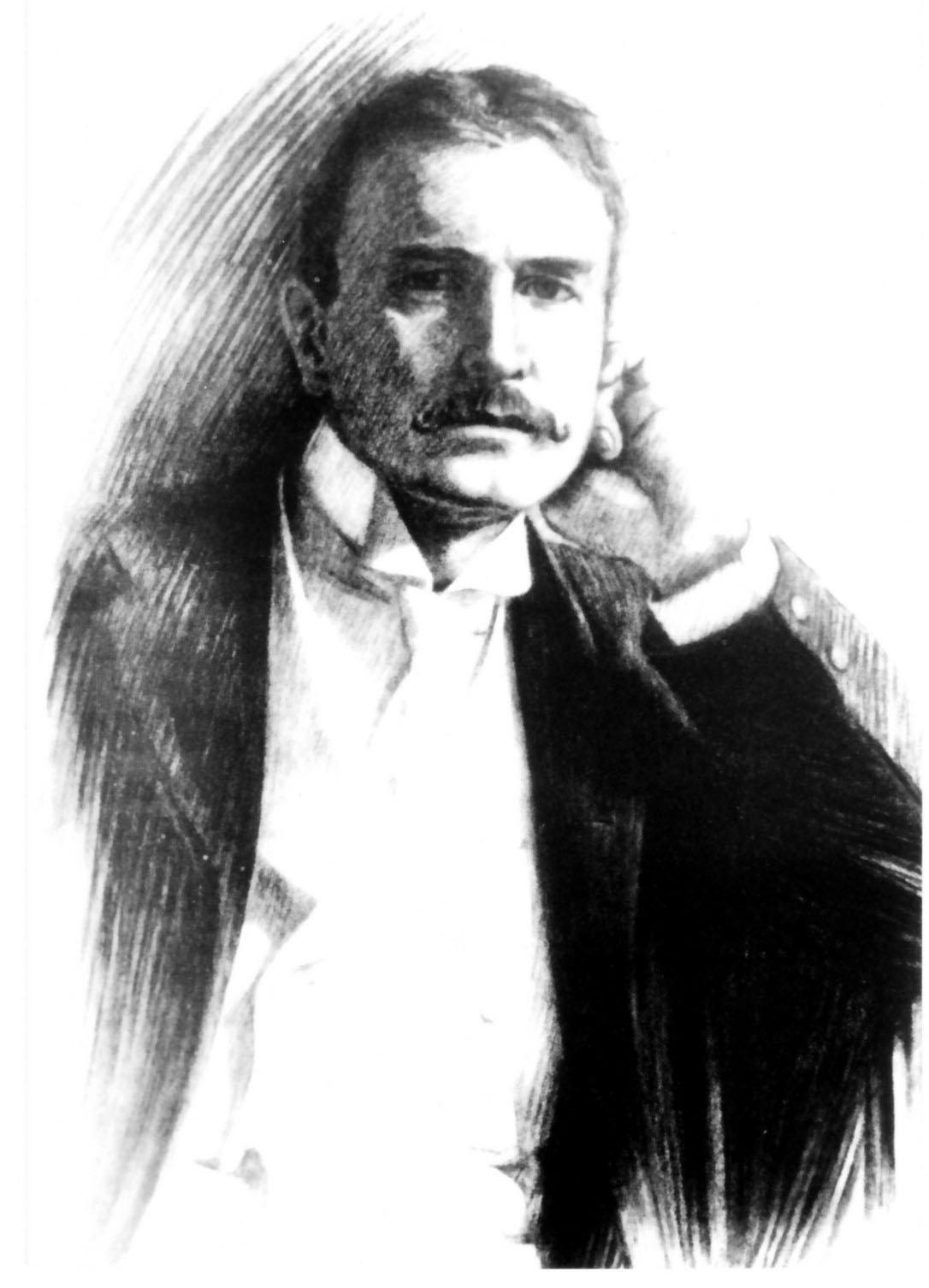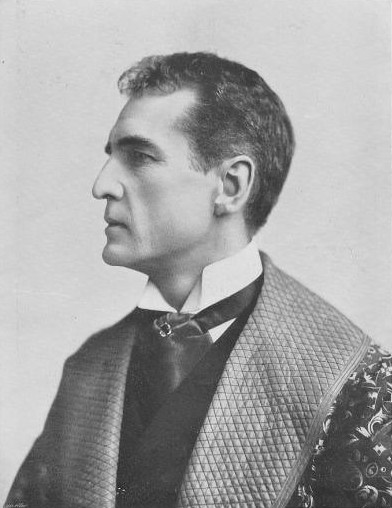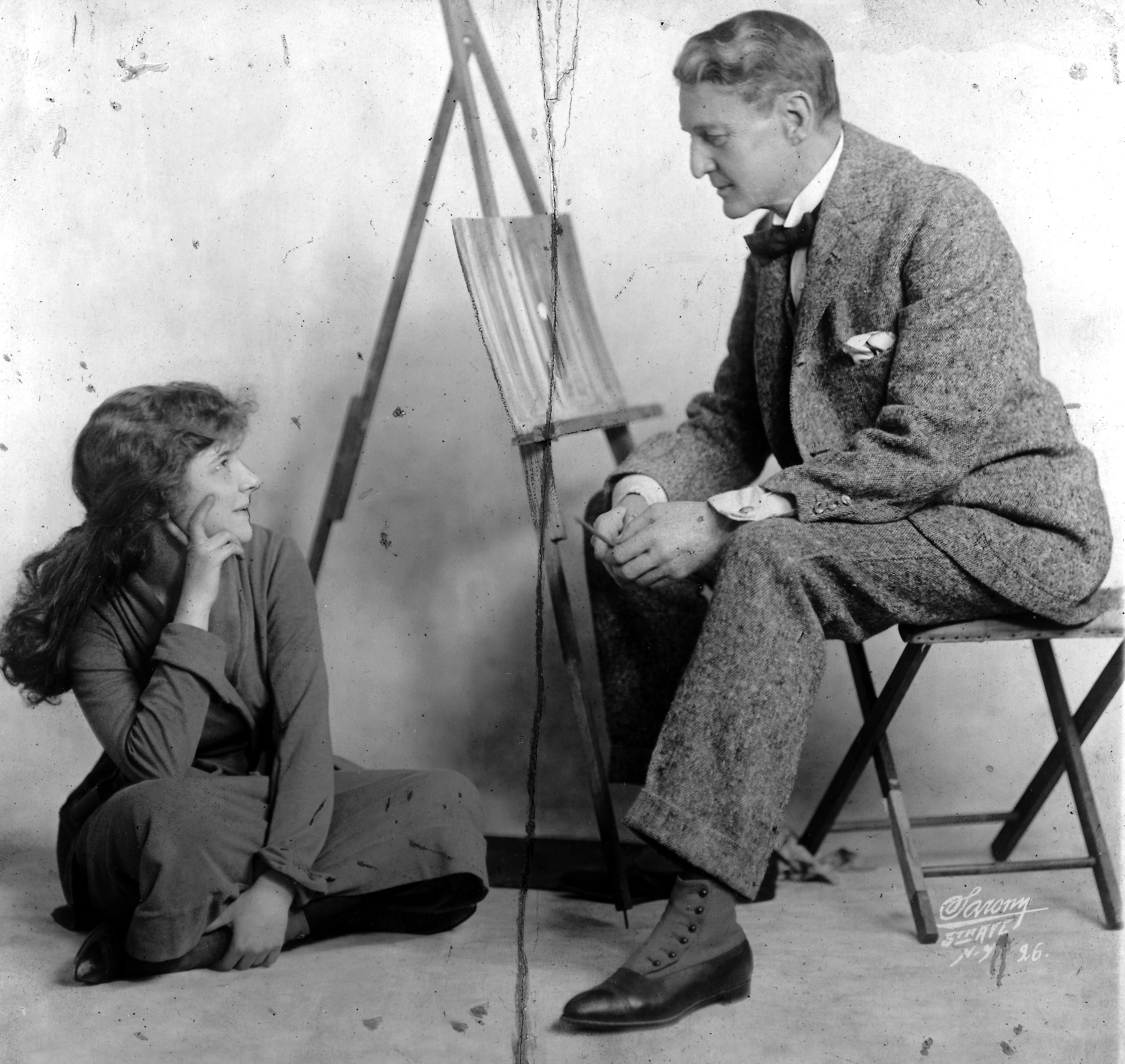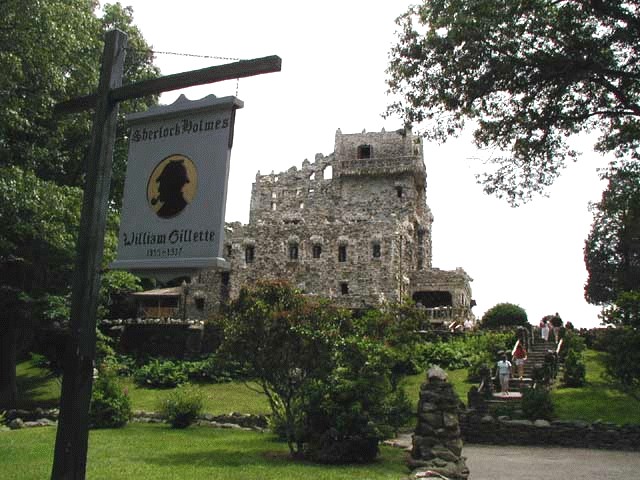William Gillette
 |
In her biography of the great French tragedian
Rachel, Rachel
Brownstein wrote this about the stars of the theater: "Stars are made up of
fictions; we acknowledge this when we call them fabulous, legendary. Images as
well as actual persons, they seem more and less real than the rest of us, and
therefore suggest that personal identity is bound up in illusions,
stereotypes, social and literary conventions." Peter Clark MacFarlane wrote in 1915 that William Gillette "has chosen to make a mystery of his existence off the stage. Nobody knows him, nobody sees him. His private character is less known than that of any other man in public life in America. People who have tried to see and know him have failed, will tell you he is cold, peculiar, taciturn, reserved, secretive, cynical, a recluse whose only intimates are cats. "Off the stage Gillette hoards his personality like a miser. On the stage he spends it like a prince. His plays and his characterization are his message to the public. The rest is silence. On the stage he is not a puppet, but a person. He wears a mask, but it is one of his own. He plays a part, but it is a part of himself, and himself is queer ~ truth to tell, odd, eccentric; no, all of these adjectives are too strong. ‘Himself’ is markedly individualistic." |
Like so many in his profession, Gillette fashioned a career out of
fictions. In another time and another place ~ let’s say, Elizabethan England ~
he would have performed in what were called masques, dramatic entertainments
designed for special occasions or holidays, or to amuse royalty. In these
little snippets of shows the performers sang, danced, read poetry, and
portrayed characters allegorical, mythological or classical. Spectacle being
all important, they wore elaborate costumes amidst minimal settings, and ~ for
good measure ~ they wore masks.
Gillette’s stage fictions were many: from Benvolio, Shylock and
Rosencrantz to Joe McCosh, Augustus Billings, Lewis Dumont, Crichton,
Carrington, Dearth, and Sherlock Holmes. These were the masks he wore on
stage. Off stage, the mask he wore was simpler but more impenetrable ~ aloof,
mysterious, eccentric, unknown and for the most part unknowable.
A master of reticence, he kept no journal, granted rare interviews,
and allowed only a privileged few inside his carefully constructed and
studiously maintained reserve. He burned most of his personal papers and
correspondence before his death. He wished most of all that no one would ever
know his secrets.
He made his living and his fortune in the most public of professions,
he was among the very best of his time at what he did, and he left an impact
still felt and acknowledged throughout the Western World nearly a century
after his death. Yet, his life remains a greater mystery than any presented on
the stage. Few knew him then. None know him now. Like the detective whose
image he created, he remains, in the words of Orson Welles, one of those
permanent profiles, everlasting silhouettes on the edge of the world. And,
there he stands, still invisible behind the mask he never removed, still known
mainly through the modern day masques he created for our entertainment.
So, just who and what was this permanent silhouette?
He invented or developed several aspects of modern theater. He helped
boost the careers of some of our most distinguished thespians. He built one of
the most eccentric homes in America. And he singlehandedly created the public
image of Sherlock Holmes.
He was born William Hooker Gillette ~ "Will" to his family and friends
~ in 1853 amidst the most cultured and intellectual haven in America. He
became a towering figure in an age of towering figures, a celebrity beyond the
scope of all but two of the neighbors of his youth. He grew up within shouting
distance of the lot on the western edge of Hartford, Connecticut, where Samuel
Clemens built his beautiful house and enjoyed his happiest and most productive
years; and he lived to be a featured speaker at the centennial celebration of
the great humorist's birth.
Gillette is best-known today as the living personification of Sherlock
Holmes. Over the years, he gave living substance to this fictional hero,
lifting him off the printed page and infusing into the character a life that
would never end. If Doyle gave Holmes to the world, it was Gillette who made
him seem so real that even today many people believe he actually lived. Georg
Schuttler, in his PhD thesis, William Gillette, Actor and Director
(University of Illinois at Urbana-Champaign, 1975), noted that By his striking
appearance, his economy of movement, and by his voice which concealed his
emotions, Gillette imparted complete realism to Sherlock Holmes. His portrayal
erased – at least for the three hours of the performance – all doubts that
such a master sleuth actually existed.
This Yankee aristocrat also established for all time the Holmes image
with the three items most associated with the master sleuth: the deerstalker
cap and the calabash pipe, thus creating arguably the most instantly
recognizable image in the world. And it was from Gillette's Holmes, not
Doyle's, that Hollywood film-makers derived four of the most famous words ever
spoken in the English language, "Elementary, my dear Watson."
But William Gillette (he never used his middle name or initial) was
more than simply the actor who gave Sherlock Holmes to the world. He was one
of the world's premier actors and playwrights before and after the turn of the
last century, a matinee idol of enormous appeal, and an imaginative genius who
made some important contributions to the theater that are still in use today.
He was to the theater what Clemens and Theodore Dreiser were to
American literature, a leading exponent of naturalism. Born in the era of
melodrama, with its grand gestures and sonorous declamations, he created in
his plays characters who talked and acted the way people talk and act in real
life. Held by the Enemy, his first Civil War drama, was a major step
toward modern theater in that it abandoned many of the crude devices of
nineteenth century melodrama and introduced realism into the sets, costumes,
props and sound effects. In Sherlock Holmes, he introduced the fade-in
at the beginning of each scene, and the fade-out at the end, instead of the
slam-bang finishes audiences were accustomed to. Clarice in 1905 was
significant because, for the first time, he sought to achieve dramatic action
through character rather than through situation and incident.
In a 63-year career, he established the strong, triumphant heroic
persona later employed on screen by John Wayne, Sean Connery and Harrison
Ford. And, along with fellow thespians John Drew, Otis Skinner, Henry Miller,
and a few others, he helped overcome America's puritanical objection to the
theater and showed that, while former actors may not have always been
gentlemen, there was no reason why a gentleman could not be an actor.
| There
are so many errors contained in the various written accounts of
Gillette's life that it is important to set these errors straight. One
may read ~ in magazine articles, books on the theater, and modern-day
internet websites ~ about his undergraduate education at some of our
leading universities, including Harvard and MIT; or that his family
disinherited him when he became an actor; or that his servant, Ozaki
Yukitaka, was ashamed of his lowly position when his famous brother, the
mayor of Tokyo, visited Hadlyme, and that Gillette and Ozaki exchanged
positions as master and servant for the famous brother's visit. Even his
age and the year of his birth are mostly listed wrong. None of this is
correct, but the public has no way of knowing the difference. In one sense, Gillette's story is not as appealing to modern readers because his was a life remarkably free of scandal. There were no paternity suits like the one that put Charles Chaplin in the 1940's headlines; no underage lovers like the girl with whom Errol Flynn cavorted; no casting couch or pornography collection like David Belasco's; not even a multitude of wives. His one marriage, while it lasted, was an idyllic romance, and his heartbreak at his wife’s death helped to disable him for half a decade. His colleagues later considered him to be quite the ladies man, and a succession of leading women was believed to have shared with him more than their dramatic talents; but this was no more unusual then than it is today; and, if the stories are true, at least he was discreet about it. |
 |
He was charmed by children, particularly young girls like
nine-year-old child star Elsie Leslie, and by such young ladies as 17-year-old
Ethel Barrymore and 18-year-old Helen Hayes (with Gillette in 1918, right);
but his interest in them was purely paternal, and his conduct, however lavish
at times, was never inappropriate. Except for the reticent Ethel, whose vanity
he wounded with a bit too much gallantry, these young girls spoke glowingly of
him for as long as they lived.
He rarely drank alcohol and smoked more on stage than off, never
indulged in drugs, and overall lived a remarkably clean life. As a subject for
psychoanalyzing, this eccentric genius might make for a remarkable study, but
scandalmongers will have to look elsewhere for their fodder.
William Gillette, America's
Sherlock Holmes is one of the few authentic
accounts of his life, and it corrects many errors and misconceptions. Yet, in
the end, when it comes to piecing together a life many decades after it has
been lived, we are drawn back to the words of Gillette’s good friend, Samuel
Clemens, who claimed to have made a discovery of "the wide difference in
interest between ‘news’ and ‘history’; that news is history in its first and
best form, its vivid and fascinating form, and that history is the pale and
tranquil reflection of it."
For the better part of a century, William Gillette made news, much of
it known throughout the western world. Today, all we can offer is a pale and
tranquil reflection of it, gathered as best we can from news clippings and
letters and the published recollections of those who knew him and shared the
news he made.
Considering that, however, those pale and tranquil reflections give us
perhaps the greatest clue to how magnificent he really was, for the range of
his friends and acquaintances was enormous. First, the people he grew up
amongst in the intellectual and literary haven of Nook Farm, two of whom ~
Harriet Beecher Stowe and Samuel Clemens (Mark Twain) ~ did as much as, or
more than, all but a handful of others in shaping the century in which they
lived. He performed with America’s greatest actor of the century, Edwin Booth;
he was personally invited to become the first American actor to take the stage
owned by the greatest British actor of the era, Sir Henry Irving; and he was
managed by the world’s foremost theatrical genius, Charles Frohman.
He gave
initial boosts to the careers of four of our most cherished thespians: Maude
Adams, Ethel Barrymore, Charlie Chaplin, and Helen Hayes. And he was the
author’s personal choice for major roles in two plays by James M. Barrie, the
creator of Peter Pan. He dined with Presidents. He entertained kings and
queens. The political cartoonist Thomas Nast, the theatrical critic Alexander
Woollcott, Utah wartime governor and doctor/dentist/lawyer/wheeler-dealer
Frank Fuller, and the creator of literature’s best-known fictional hero, Sir
Arthur Conan Doyle, were his friends. As for admirers, simply create a Who’s
Who of the Western World for the last three decades of the nineteenth century
and the first three decades of the twentieth, and you’ll pretty much have
them.
His many other friends and admirers cover a broad landscape of the
international scene. They were enormously different, extraordinarily gifted
and brilliant, and possessed both a rare vitality and an immense sense of
purpose that shaped the times in which they lived. It is they ~ probably more
than anything in particular that Gillette ever accomplished ~ that made for
what was, after all, a very extraordinary life.
But, more than any play he ever wrote or acted in, William Gillette's
masterpiece was his retirement home, what the Washington Post called
the acme of his dreams, which ironically he never referred to as a castle,
although his neighbors often did. He once called it his "Hadlyme stone heap.
Others called it the rock pile or Gillette's folly."
Today, it is known around the world simply as Gillette Castle, and to
this day it summarizes the success upon which all his dreams were built,
dreams that turned his picturesque estate into a small boy’s dream of
paradise. He called his new monstrosity Seventh Sister, because the hill on
which it sits is the last of seven hills long referred to as the Seven
Sisters. Every inch, every corner, every crevice, every device, and every
accoutrement, was built according to his own design, including the outer
fieldstone walls, the crenelated towers, the entire floor plan, the interior
doors with their complex latches, and the special built-in furniture. It was
built of local fieldstone and cement, with an interior of southern white oak,
a wood so pure it has no knotholes in it and so durable it has withstood
nearly a century of wear. The castle contains 24 rooms and occupies about
14,000 square feet. The castle contains several mazes, hidden rooms and
passageways. There are 47 hand-carved doors, each unique in its design and
each with its own unique latch devised by the puzzle-loving dramatist. The
door latches, light switches, bolts and window fastenings took a local
carpenter an entire year to construct. The light switches are among the most
unique parts of the castle: some are fashioned after backstage theater levers,
others like steam locomotive levers.
The walls, of solid native granite, are five feet thick at the base
and taper to a thickness of two feet at the tower. The entire castle is
steel-framed but covered with either native field stone or the southern white
oak. The interior walls were covered with Javanese raffia matting, the only
imported thing in the castle, which was once very colorful but had faded
through the years; it was refurbished during the recent renovation. The mortar
holding the stones together, however, while white everywhere else, is colored
burgundy inside to add to the colorful decor.
Gillette Castle still sits majestically at the edge of the cliff two
hundred feet above the Connecticut River. It commands a broad panoramic view
of the river and the surrounding countryside, a view that is particularly
spectacular in the fall. A state park today, four miles south of East Haddam,
the castle is open to the public from 10:00 a.m. to 5:00 p.m. daily from
Memorial Day to Columbus Day. Along with numerous newspaper and magazine
articles over the years, it was featured in National Geographic's Guide to
America's Great Houses (1999). Each year, the castle draws more than
100,000 visitors, to whom it stands as a testimony and a monument to the man
who built it. Henry A. Perkins concluded, "This ‘Castle’ is a tangible
expression of that personality, winning, whimsical, aloof, and will long stand
as his most perfect memorial when his plays and his rôles in them have been
forgotten."
At his Hadlyme castle estate, Gillette entertained many friends, the
most illustrious of them being President Calvin Coolidge, physicist Albert
Einstein, and Tokyo Mayor Ozaki Yukio, whose 1912 gift of the Japanese cherry
blossoms still beautifies the nation’s Capitol; and they all took a ride on
his miniature railroad.
Few names in the pantheon of dramatic artists are as illustrious as
his. Yet so many from his era are unknown today because they didn’t do what it
took to be remembered. What does it take? "For any actor to achieve some
measure of immortality", George Rowell observed, "he must have won success in a
‘classic’ role."
A few ~ a very few ~ achieve longer lasting fame, not just because of
their talents, but because they were blessed with a particular role, a
particular stage or film vehicle that would always be talked about long after
they were gone: Charlie Chaplin as the Little Tramp; Clark Gable as Rhett
Butler in Gone With the Wind; Errol Flynn as dashing boxer James J.
Corbett in Gentleman Jim; Frank Sinatra as the skinny, luckless Private
Maggio in From Here to Eternity; Barbra Streisand as New York-born
Fanny Brice in Funny Girl; Sean Connery as Agent 007; and Harrison Ford
in the Indiana Jones trilogy.
Certainly, Sherlock Holmes was the role Gillette was born to play, and
it is because he played it that his name is known today. The binding of the
actor to the role is one of those historical happenings that border on the
miraculous. There was simply no other actor at that time who could have done
with the character what he did; and, as Holmes aficionados are well aware,
the great detective is the most satisfying character in all the world’s
literature. It is a character to make a man immortal, and that was what it did
for Gillette.
Helen Hayes admitted, "I've admired other people in the role because
it's such a good play, but William Gillette is the only real Sherlock Holmes
for me, or for anyone else whoever saw him, I'm sure."
Walter Prichard Eaton wrote that "nobody who ever saw him as Sherlock
Holmes will think of him first in any role but that. The impersonation was one
of those rare and unforgettable marriages between a player and his part which
occur but seldom in a generation, and are always enshrined in theatrical
history."
And Vincent Starrett concluded,
"There can be little doubt that the
play also settled for all time the popular reputation of Mr. Gillette. Famous
as was his Secret Service and delightful as are contemporary memories
of his appearance in, say, The Admirable Crichton and Dear Brutus,
it is as the living embodiment of Sherlock Holmes that he will go down the
happy boulevards of time. It is not a bad fate."
Gillette was so divinely suited to the role that Doyle once told him
his only complaint was "that you made the poor hero of the anaemic printed
page a very limp object as compared with the glamour of your own personality
which you infuse into his stage presentment."
And Booth Tarkington paid him the most lyrical and heart-felt
compliment ever given to an artist: "I would rather see you play Sherlock
Holmes than be a child again on Christmas morning."
In appearance, personality, and acting ability, Gillette remains for
many to this day and for all time the definitive Sherlock Holmes.
Unpublished work © 2006 Henry Zecher